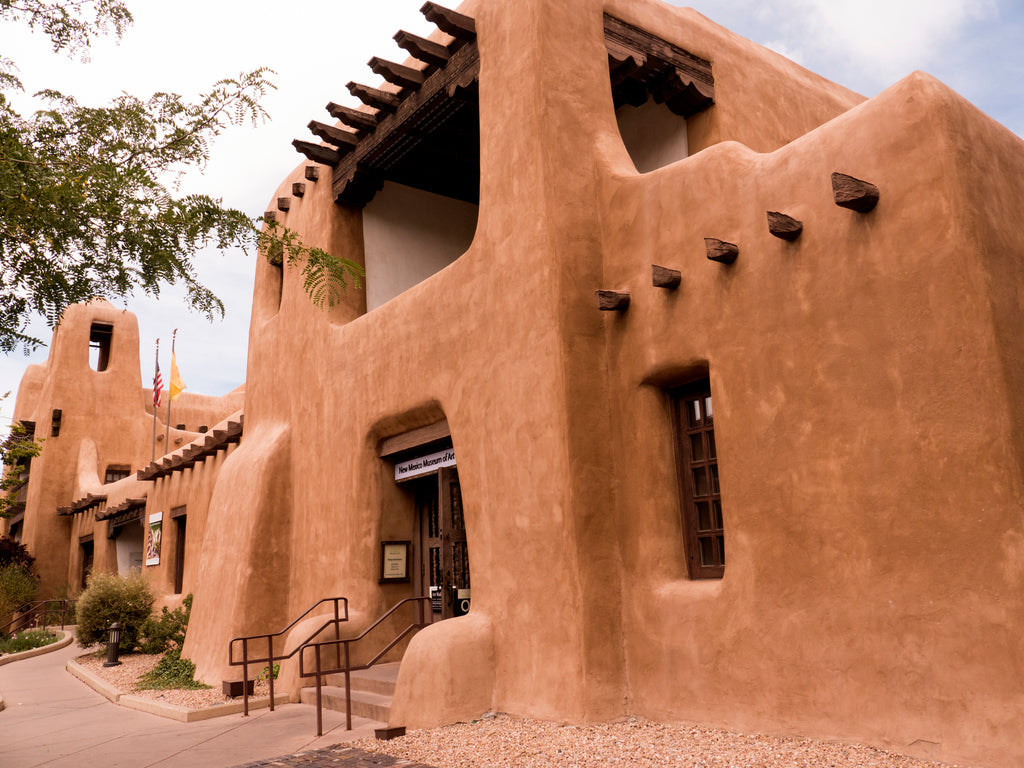Mixing it up in New Mexico (by Mike Baker)
New Mexico is truly the best of both worlds: rich in human and natural history, the southwestern state also enjoys its current status as one of the most popular destinations for tourism and retirement in the U.S. It's a perfect blend of old and new, high and low, cold and hot, spicy and mild, earth and sky.
Whether you're visiting the Sangre de Cristo mountains in the north, the High Plains in the east, the Basin in the south, or the Colorado Plateau in the (north) west, the distinct sights and smells of New Mexico are everywhere: the smell of piñon wood burning in kiva fireplaces, adobe pueblo homes (in both historic and modern contexts), fiery fronds of chile ristras hanging from the eaves, and – after the sun sets – diamond-perfect starlight.

A typical New Mexico adventure begins in Albuquerque. Just south of the Albuquerque International Sunport (no joke – there are hundreds of solar panels that provide power to the airport’s outbuildings), Kirtland Air Force Base hosts the Starfire Optical Range, one of the largest telescopes in the world for tracking satellites. In fact, thanks to New Mexico’s low humidity and relatively high altitude, the southwest quadrant of the state has more observatories per square mile than anywhere else in the country. Optimal atmospheric conditions also account for the Albuquerque International Balloon Festival, which occurs every October.

Aside from perhaps having the best posole – the traditional Puebloan stew of hominy (corn), pork, and red chile simmered in a savory broth — in New Mexico, Albuquerque excels in reminding visitors of its prehistoric past through Petroglyph National Monument. The site is host to over 20,000 images carved into basalt boulders by Ancestral Puebloans.

<Photo above by Steven C. Price - CC BY-SA 3.0, https://commons.wikimedia.org/w/index.php?curid=43082325 by Steven C. Price, Associate V.P. for Technology Development at Oklahoma State University>


The site is a fitting introduction to the broader Ancestral Puebloan culture and its chief landmarks that dominate the area: Chaco Culture National Historical Park, Mesa Verde National Park (just over the border in Colorado), Bandelier National Monument, and Shiprock Peak (above) near the Four Corners region.
Sixty miles west of Albuquerque sits Acoma Pueblo, a National Historic Landmark and home of the Acoma Pueblo tribe since the 11th century, making it one of the oldest centers of population in the United States. Inhabited today by 30 permanent residents, the village's 300+ adobe buildings (whose upper floors are accessed using ladders) sit atop a mesa that provided the original inhabitants a natural defense against rivals– not to mention 16th century Europeans.
An hour's drive from Albuquerque, the capital city of Santa Fe is a Southwestern hub for traditional culture, history, and modern fine art. Though the Georgia O'Keefe Museum and the Museum of International Folk Art are spectacular, one of the best places to experience Santa Fe's artistic side is the renowned Canyon Road, home to a wealth of studios and galleries.
The city is very walkable, allowing one to sample art, history, and cuisine all on the same scenic stroll. The uniquely-shaped capitol building, regarded as the oldest, longest-serving capitol in the country, is just a block away from historic San Miguel Chapel, the oldest church structure in the U.S. with adobe walls built by the Tiaxcalan people from Mexico in 1610.

Sixty miles further north is Taos. Famous for its 104 year-old artist colony, it is also renown for the Taos Pueblo village, a community regarded for its ancestral, colonial, and geologic significance in this region.
Though atypical of what one might believe to be "art", the nearby Earthship Community offers several working examples of sustainable architecture. Begun by Michael Reynolds in the 1970s, the site is just beyond the Rio Grande Gorge Bridge and definitely sparks curiosity with its unconventional functionality.
A UNESCO World Heritage Site and National Historic Landmark, Taos Pueblo is the home to about 150 people beneath the shadow of Pueblo Peak. Thought to have been built between 1000 and 1450 A.D., the Taos Pueblo is the largest Pueblo complex that exists today. Per tradition, modern conveniences such as electricity, running water, and plumbing are not allowed.
Martinez Hacienda is one of Taos's few remaining great houses from the late Spanish colonial period, a robust building with thick adobe walls that marked the northern boundary of Spain's empire in North America. The museum's 21 rooms and two courtyards are rich with artifacts that depict the growing American West, with plenty of references to explorers Kit Carson and Jim Bridger, whose saddle is prominently displayed.

Further afield, Bandelier National Monument reminds visitors again of the area's Ancestral Puebloan past. Nestled within Frijoles Canyon, the site features the remnants of the Tyuonyi pueblo and a reconstructed kiva, a room for spiritual reflection built into a platform at the top of a cliff accessible only by stairway and wooden ladder.
Like what you see? Find all of our New Mexico travel art + 1,700 more original designs @ adgstore.com. Shop for hand-illustrated art prints, postcards, notecards, canvas banners, coffee table books, and more. All created and printed in the USA.
Above: our Santa Fe: Print Shop design on the all-new TwoSticks Canvas Banner
← Older Post Newer Post →















